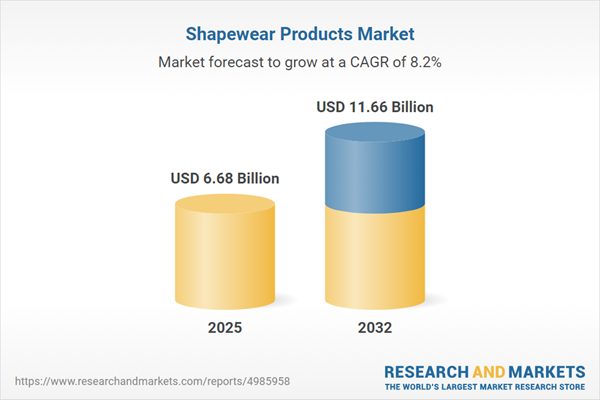Speak directly to the analyst to clarify any post sales queries you may have.
The shapewear products market is shifting quickly as brands and manufacturers respond to rising consumer demands for comfort, sustainability, and technological progress in apparel. Senior decision-makers need actionable insights on market dynamics, evolving segmentation, and the implications of regulatory changes to guide strategic investments and maintain a competitive edge.
Market Snapshot: Shapewear Products Market Growth Trajectory
The global shapewear products market advanced from USD 6.18 billion in 2024 to USD 6.68 billion in 2025 and is projected to attain USD 11.66 billion by 2032, supported by a CAGR of 8.24%. This sustained expansion is being propelled by the convergence of technical fabric innovation, growing emphasis on inclusive sizing, and the transformation of consumer purchasing behaviors. Demand is extending across diverse demographics, with adoption strengthened by omni-channel distribution—including direct-to-consumer digital platforms and traditional offline retail networks. As leading brands leverage advanced knitting and seamless garment technologies, market boundaries between shapewear and performance apparel continue to blur, paving the way for broader industry adoption.
Scope & Segmentation of the Shapewear Products Market
- Product Types: Bodysuits (including full body and mid-thigh), control briefs, thigh shapers (knee high and mid thigh), and waist cinchers.
- End Users: Men and women, each with distinctive product needs and preferences.
- Material Types: Cotton blends for breathability and softness, nylon blends for durability and stretch, and spandex blends (with options for high and low spandex content) for varying levels of shaping and support.
- Distribution Channels: Offline (department and specialty stores) and online (brand-owned sites, e-commerce platforms, and third-party retailers), offering varying levels of consumer interaction and service.
- Regional Coverage: Americas (including United States, Canada, Mexico, Brazil, Argentina, Chile, Colombia, Peru), Europe, Middle East & Africa (countries such as United Kingdom, Germany, France, Russia, Italy, Spain, UAE, Saudi Arabia, South Africa, Nigeria), and Asia-Pacific (including China, India, Japan, Australia, South Korea, Indonesia, Thailand, Malaysia, Singapore, Taiwan).
- Technology Integration: Seamless knitting, 3D knitting, moisture management innovations, digitally engineered compression zones, and AR-enabled virtual try-on experiences are accelerating product differentiation and enhancing fit accuracy.
- Leading Companies Analyzed: Spanx, Wacoal Holdings, Hanesbrands, SKIMS, Triumph International, Victoria's Secret, Soma Intimates, Leonisa, Yummie, and Jockey International.
Key Takeaways for Senior Decision-Makers
- Sustainability has become central to product innovation, with brands adopting recycled fibers and circular production to address rising consumer eco-consciousness and regulatory standards.
- Inclusive design initiatives, such as extending size ranges and employing gender-neutral cuts, are broadening market reach and improving brand loyalty among previously underserved demographics.
- Technical advances, particularly in seamless and 3D knitting, have enabled the integration of performance and shaping features, improving garment comfort and adapting to diverse body contours.
- Direct-to-consumer strategies, social commerce, and subscription models are altering go-to-market tactics, building robust digital communities and streamlining customer journeys.
- Strategic alliances with influencers, wellness experts, and textile innovators are reinforcing product credibility and enhancing storytelling effectiveness for targeted marketing campaigns.
- Investments in supply chain tracking tools and data analytics are equipping brands to respond faster to market shifts and anticipate evolving consumer behavior.
Tariff Impact and Strategic Sourcing Considerations
Recent tariff increases on textiles and apparel in the United States have complicated cost structures and prompted companies to review sourcing models. Many industry players are exploring nearshoring in Latin America to leverage preferential trade agreements and reduce lead times, while select onshoring efforts prioritize greater quality and control. Implementing duty engineering processes and optimizing material classification within product design cycles are becoming necessary to mitigate tariff exposure, sustain pricing strategies, and protect margins in a volatile trade landscape.
Methodology & Data Sources
This analysis combines thorough secondary research across trade publications, industry and regulatory reports, and textile associations, paired with structured interviews from stakeholders throughout the value chain. Quantitative assessments focus on production, sourcing, and distribution, with triangulation to verify data integrity and segmentation frameworks guiding analytical depth across all market categories.
Why This Report Matters for B2B Strategy
- Identifies high-impact trends driving market evolution, equipping leaders to align business strategies with emerging consumer and regulatory priorities.
- Delivers segmentation-driven insights enabling tailored portfolio management and effective regional expansion approaches.
- Clarifies the impact of tariffs and supply chain dynamics, supporting procurement optimization and risk mitigation efforts for executive planning.
Conclusion
The shapewear products market is entering a period defined by rapid innovation, sustainability focus, and channel diversification. Companies that proactively advance technical, inclusive, and digital capabilities are well positioned to secure growth and adapt to evolving global market conditions.
Additional Product Information:
- Purchase of this report includes 1 year online access with quarterly updates.
- This report can be updated on request. Please contact our Customer Experience team using the Ask a Question widget on our website.
Table of Contents
3. Executive Summary
4. Market Overview
7. Cumulative Impact of Artificial Intelligence 2025
Companies Mentioned
The companies profiled in this Shapewear Products market report include:- Spanx, Inc.
- Wacoal Holdings Corp.
- Hanesbrands, Inc.
- SKIMS Corp.
- Triumph International AG
- Victoria's Secret & Co.
- Soma Intimates, LLC
- Leonisa S.A.
- Yummie, Inc.
- Jockey International, Inc.
Table Information
| Report Attribute | Details |
|---|---|
| No. of Pages | 184 |
| Published | October 2025 |
| Forecast Period | 2025 - 2032 |
| Estimated Market Value ( USD | $ 6.68 Billion |
| Forecasted Market Value ( USD | $ 11.66 Billion |
| Compound Annual Growth Rate | 8.2% |
| Regions Covered | Global |
| No. of Companies Mentioned | 11 |









